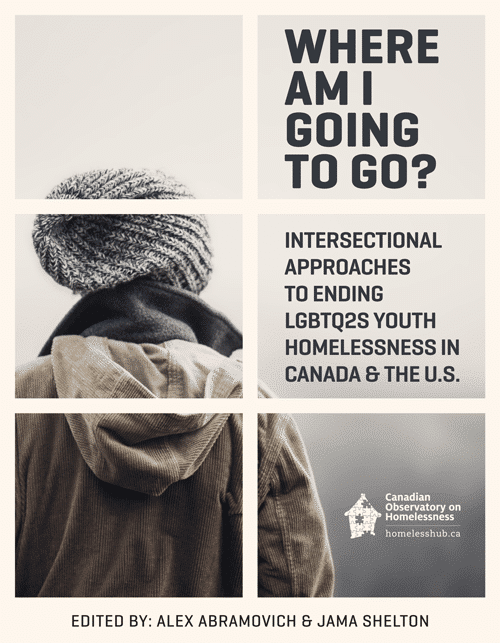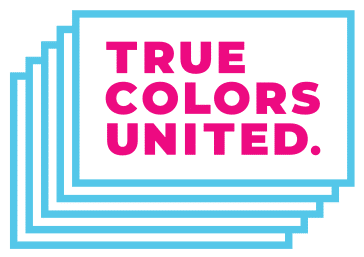When it comes to putting big ideas into action, education is essential. We’re proud to say that True Colors Fund staff (both past and present) have contributed to creating the first academic text focusing on LGBTQ2S youth homelessness.
The book, Where Am I Going to Go? Intersectional Approaches to Ending LGBTQ2S Youth Homelessness in Canada & the U.S., is described as a “project of love and hope.” Edited by Alex Abramovich and True Colors Fund Strategy Advisor Jama Shelton, the book aims to create a shift in our collective response to LGBTQ2S youth homelessness – so that all young people have a safe place to call home. Our very own Chief Program Officer Ian Ellasante, Program Officer Christa Price, and former Program Associate Coco Wheeler penned a chapter themselves about different pathways into and out of homelessness.
The complete book will be available to download for free as a PDF on the Homeless Hub website. Pre-orders for the paperback are also available and will be sold through the York University Bookstore.
We’re excited to share with you the “Letter to the Reader”* to the new book! Check it out:
Where am I going to go? What am I going to do? Throughout our careers, we’ve been asked these questions by LGBTQ2S young people experiencing homelessness a countless number of times. We’ve been asked versions of the same questions by service providers working with youth experiencing homelessness, advocates for LGBTQ2S youth, and policy makers – – Where do we go from here? What are we going to do?
The problem of LGBTQ2S youth homelessness can overwhelm us if we let it. It is a big problem, involving other big problems, like poverty, racism, cissexism, transphobia, heterosexism, homophobia, and colonialism. We see the impact of these, and LGBTQ2S young people experiencing homelessness live the impact of these, every day. For example, some of us live in cities or provinces that are unwelcoming to LGBTQ2S people. This, in turn, may make the available services for LGBTQ2S young people equally as unwelcoming.
Almost all LGBTQ people going into shelters have a fear of them, because it isn’t a matter of if it’s dangerous, but just how dangerous it will be.
Many of us live in cities or provinces that are hostile towards Indigenous youth and Black youth, often resulting in violence towards youth of colour, stigma, and social isolation. Systems are often not designed to meet the specific needs of youth who have experienced multiple stigmas related to racism, homophobia, and transphobia. As such, providers working within these systems may not always understand how to meet the needs of youth with intersecting identities, leaving LGBTQ2S youth of colour experiencing homelessness with few places to turn to for support.
As a queer person I can find a few resources which may help, but as a black trans woman, the margins are even more narrow.
Most of us live in places that criminalize the experience of homelessness. The notion that youth experiencing homelessness make the streets unsafe is still a widely held belief. Public discourse on crime and homelessness tends to revolve around youth experiencing homelessness as the perpetrators of crime, rather than the victims, which has been a key factor leading to the criminalization of homelessness. However, a major part of the problem is that there is not nearly enough housing for youth experiencing homelessness, leaving young people with no choice, but to fend for themselves. Youth are then criminalized for figuring out how to survive without any support or assistance; they are ticketed for sleeping outside, trespassing, and loitering. And when they engage in street economies to buy the things that they need, they are arrested.
That’s when I started getting in trouble, like, with the police and everything.
So, where do we go from here? What are we doing to do? We hope this book will provide some direction. It includes some of the latest research related to LGBTQ2S youth homelessness, as well as case studies of innovative program models that are working alongside LGBTQ2S youth experiencing homelessness in Canada and the U.S. It also includes wisdom from several young people who have experienced homelessness. We believe that those most impacted by LGBTQ2S youth homelessness – LGBTQ2S youth themselves – must be at the center of conceptualizing and creating the solutions that will help us end LGBTQ2S youth homelessness.
As queer researchers with a profound understanding of family rejection and the complexities of coming out, as well as the relationship between coming out and homelessness, we are deeply connected to this work. Our relationship to this work has taught us about reflexivity and the importance of being reflective researchers.
We approached the creation of this book, much like we approach our everyday work, committed with a full heart. This is a project of love and hope. We put this book out into the world with the hope that it may help create a necessary shift, so that all young people have a safe place to call home, and that together we may work to end LGBTQ2S youth homelessness.
If you like what you see, you can download a free copy here. Hard copies are also available.
*This letter originally appeared on Homeless Hub’s blog and is being shared/re-published on the True Colors Fund’s website.
